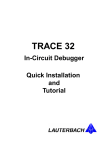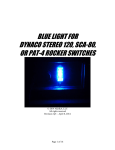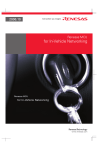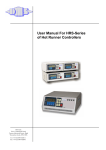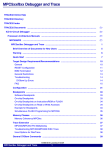Download `Mapping` in `ICE Emulator for PowerPC`
Transcript
ICE Emulator for PowerPC
TRACE32 Online Help
TRACE32 Directory
TRACE32 Index
TRACE32 Documents ......................................................................................................................
ICE In-Circuit Emulator .................................................................................................................
ICE Target Guides ......................................................................................................................
ICE Emulator for PowerPC .....................................................................................................
1
WARNING ..............................................................................................................................
4
Quick Start ............................................................................................................................
5
Troubleshooting ...................................................................................................................
6
Hang-Up
6
Dualport Errors
6
FAQ ........................................................................................................................................
7
Basics ....................................................................................................................................
8
SYStem.Mode
9
SYStem.Clock
Clock generation
10
Dualport Modes
10
Mapping and CS Setting of the MPC505, PPC403
11
Mapping and CS setting of the MPC860/821
11
Jumper Settings of the MPC860/821 Probe
13
Adaption to different Clock Sources of the MPC860/821 Probe
14
Layout of the MPC860/821 Probe
15
General SYStem Settings and Restrictions .......................................................................
General Restrictions
18
18
SYStem.Option PreMap
SYStem.Option PreMapMod
SYStem.Option TestClock
Address lines
19
Premapper mode
19
Clock test
20
Break mask
21
SYStem.Option FREEZE
Timer freeze modes
21
SYStem.Option VSYNC
Synch trace signals
22
SYStem.Option BreakMask
SYStem.Option CFLUSH
Instruction cache flush
22
SYStem.Option ONCE
On-circuit emulation
22
SYStem.Option BASE
Peripheral base address
23
Reset configuration
23
SYStem.Option RESETCONF
SYStem.Option IBUS
SYStem.Option ICFLUSH
©1989-2015 Lauterbach GmbH
ICE Emulator for PowerPC
1
IBUS control
23
Internal instruction cache flush
23
SYStem.Option ICREAD
SYStem.Option DCREAD
Instruction cache read
24
Date cache read
24
SYStem.Option WATCHDOG
Disable watchdog
24
SYStem.Option BRKNOMSK
tbd.
24
SYStem.Option FlowTrace
tbd.
25
SYStem.Option ResetExt
tbd.
25
SYStem.Option ResetMode
tbd.
25
SYStem.Option SCRATCH
tbd.
26
SYStem.Option TURBO
tbd.
26
System wait states
26
Exception Control ................................................................................................................
27
SYStem.Option Wait
Schematics
27
RESET
28
eXception.Activate
Force exception
eXception.Enable
29
Enable exception
31
Stimulate exception
32
Mapping .................................................................................................................................
34
eXception.Pulse
MAP.BUS
Bus width mapping
34
CPU specific MMU commands ............................................................................................
35
MMU.TLB
Display MMU TLB entries
35
Load MMU TLB entries
35
Memory Classes ...................................................................................................................
36
MMU.TLBSCAN
State Analyzer .......................................................................................................................
37
Keywords for the Trigger Unit
37
Keywords for the Display
37
Port Analyzer ........................................................................................................................
Keywords for the Port Analyzer
38
38
Additional Trace Channels
40
Module PPC403GA
40
Module MPC505
40
Module MPC860/MPC821
41
Compilers ..............................................................................................................................
42
3rd Party Tool Integrations ..................................................................................................
43
Realtime operation Systems ...............................................................................................
44
Emulation Modules ..............................................................................................................
45
Module Overview
45
Order Information
46
Operating Voltage ................................................................................................................
47
Physical Dimensions ...........................................................................................................
48
©1989-2015 Lauterbach GmbH
ICE Emulator for PowerPC
2
Adapter ..................................................................................................................................
©1989-2015 Lauterbach GmbH
ICE Emulator for PowerPC
3
53
ICE Emulator for PowerPC
Version 06-Nov-2015
P:FFF00FC4
E::w.d.l
addr/line
535
P:FFF00FC4
P:FFF00FC8
P:FFF00FCC
P:FFF00FD0
\\DIABC1\main
..DA....T.... MIX
E::w.per
code
{
9421FFD8
7C0802A6
93E10024
9001002C
539
label
mne
Processor Version
stw PVR
00200001 FAM
mfl
MAJ
stw
stw Timer
int j;
TSR
44000000 WIS
char * p;
TCR
00000000 WP
PIE
vtripplearray[0][0][0 PIT
00000000
main:
E::w.a.l
record run address
cycle
-000003 f
P:FFF00FC4 fetch
532
533
534 main()
535 {
trap
-000002
/
mflr
r0
-000001 BRK
d.l
symbol
7FE00008 \\DIABC1\main
00000002
00000000
ME
MI
pending WR
2^17 WPC of
disable FP
1
E::w.v.l
main()
j = 1
p = 0x0
For general informations about the In-Circuit Debugger refer to the ”ICE User’s Guide” (ice_user.pdf). All
general commands are described in ”IDE Reference Guide” (ide_ref.pdf) and “General Commands and
Functions”.
©1989-2015 Lauterbach GmbH
ICE Emulator for PowerPC
4
WARNING
NOTE:
Do not connect or remove probe from target while target power is ON.
Power up:
Switch on emulator first, then target
Power down: Switch off target first, then emulator
©1989-2015 Lauterbach GmbH
ICE Emulator for PowerPC
5
WARNING
Quick Start
tbd.
©1989-2015 Lauterbach GmbH
ICE Emulator for PowerPC
6
Quick Start
Troubleshooting
Hang-Up
tbd.
Dualport Errors
tbd.
©1989-2015 Lauterbach GmbH
ICE Emulator for PowerPC
7
Troubleshooting
FAQ
©1989-2015 Lauterbach GmbH
ICE Emulator for PowerPC
8
FAQ
Basics
The ICE-PPC emulation head supports MPC500 and MPC800 series derivatives from Freescale
Semiconductor and PPC400 series derivatives from IBM:
•
PPC403GA
•
MPC505
•
MPC821
•
MPC860
The adaption to different probes is done by changing the module. Modules support BGA or QFP versions,
where applicable. The emulation frequency is up to 20MHz with 0 wait states and up to 28 MHz with 1 or
more wait states. There is no significant speed difference to realtime because target systems in most cases
use wait states and fast program loops are running from the cache. This leads to an average performance
reduction of only about 10% using three wait states.
The probe uses a special emulation concept (active/passive emulation) to provide either emulation in
realtime in the target or the advanced emulation features of Trace32 with reduced speed.
Therefore the probe contains three parts. The top level is the passive emulation module. It contains the
drivers for addresses, data and ports, the control for the bus interface, the dualport and the BDM. The
second level is the active CPU module, it contains the CPU, the interrupt-, reset-enable and the clock
switches, the pull-up resistors for the CPU and the control of the switches and the buffers on the buffer
module. The third level is the buffer module. It contains the address and data buffers between the CPU and
the target. The modules are connected with the target connector for the CPU signals (e.g ET160) and
additional an intermodul connector for the control signals. You can put these three modules one on the other.
If you want to use all emulation features (Internal mode, internal mapping, internal clock) you need all three
of the modules.
If you want more speed in your target memory, you can leave out the buffer module (the buffers have a few
ns delay). The restriction now is, that you can map internal memory only if no buffer on your target is
decoded at the same address, and that the synchronous breakpoints does not work with external memory. If
your target memory is a ram, you can use software breakpoints instead.
If you have already soldered a CPU on your target, you can work in passive emulation. You need only the
passive module. The CPU on your target is operated via the BDM port. Advantage is, that there is no time
delay. Restrictions: Same as above and also no internal clock mode and no enable/disable of the interrupts
and the reset lines.
An additional slot in the base modul offers upgrading with the port analyzer to get timing and state of the
CPU ports.
We use a different system for numbering the address and data lines as it is used in the PowerPC
descriptions. Our least significant bit is called D0 or A0, the MSB D31 or A31. Don't be confused, if you find
some differences between your databook and perhaps our peripheral window.
©1989-2015 Lauterbach GmbH
ICE Emulator for PowerPC
9
Basics
SYStem.Mode
E::w.sys
system
Down
Up
RESet
cpu-type
PPC403
25 MHz
Mode
RESet
Analyzer
Monitor
ResetDown
ResetUp
NoProbe
AloneInt
AloneExt
EmulInt
EmulExt
Clock
VCO
Low
Mid
High
TimeReq
1.000ms
TimeOut
50.000us
Access
Nodelay
Wait
Request
Denied
Option
PreMap
TestClock
Option
0.
Wait
0.
The emulation head can stay in 6 modes. The modes are selected by the SYStem.Up or the SYStem.Mode
command.
Format:
SYStem.Mode <mode>
<mode>:
ResetDown
ResetUp
AloneInt
AloneExt
EmulInt
EmulExt
Reset Down
Target is down, all drivers are in tristate mode.
Reset Up
Target has power, drivers are logically in inactive state, but not tristate.
Alone Internal
Probe is running with internal clock, driver inactive. (Only with active
module and buffer module.)
Alone External
Probe is running with external clock, driver inactive. (Only with active
module and buffer module.)
Emulation Internal
Probe is running with internal clock, strobes to target are generated.
(Only with active module, buffer module optional)
Emulation External
Probe is running with external clock, strobes to target are activated.
(Active module and buffer module optional)
In active mode, the power of the target is sensed and by switching down the target the emulator changes to
RESET mode. The probe is not supplied by the target. When running without target, the target voltage is
simulated by an internal pull-up resistor.
©1989-2015 Lauterbach GmbH
ICE Emulator for PowerPC
10
Basics
SYStem.Clock
Clock generation
Format:
SYStem.Clock <option>
<option>:
VCO
High
Mid
Low
VCO
Variable frequency 1 … 35 MHz.
Low, Mid,
High
2.5, 5.0 or 10.0 MHz.
Dualport Modes
Format:
SYStem.Access <mode>
<mode>:
Request
Denied
Dualport access modes.
Request
The CPU bus access is stopped by the bus request signals for dualport access.
Denied
No dualport access is allowed while the realtime emulation is running.
©1989-2015 Lauterbach GmbH
ICE Emulator for PowerPC
11
Basics
Mapping and CS Setting of the MPC505, PPC403
The PowerPC controllers have bus interfaces, which allows the CPU to communicate with the external
memory and peripherals without external logic. In the emulator, we use an epld to rebuild an address and
data strobe out of the different chipselect lines of the CPU. For programming this epld, it is necessary for us
to know, how the user has programmed the bus interface.
So, it is necessary for us to know these settings before delivering, to adapt this reconstruction epld to your
target.
If the CS settings change during the project, it is possible to reprogram this epld. It is possible to reprogram it
by sending a programming batch file to the customer.
Mapping and CS setting of the MPC860/821
Normally, it is possible to map the user ram of an MPC860 emulator without any application specific epld.
The following rules should enable you to make your own mapping:
1.
Set the SYS.OPTION PreMapModule off
2.
Set your CS registers in the way you want the mapping. If you use the UPMA or UPMB DRAM
access, the start address multiplex bit (CSNT/SAM) in the option register of the CS must be 0.
The emulator uses the first cycle of the memory access to latch the internal addresses. With this
bit at 0, the first cycle of the DRAM access is not multiplexed, but shows the internal addresses
on the address pins. For accessing your target memory, it is necessary to change the
programming of the UPM RAM. It is recommended to use internal emulation memory instead of
the external target DRAM. Then, you don’t have to care for the UPM settings. Find more
Information about this matter in the chapters External Bus Interface and Memory Controller of the
user manual
CLKOUT
Typical DRAM Access
0 Waitstates
SAM = 1
TS
TA
ADDR
ROW
COLLUMN
DATA
RAS/CS
CAS
©1989-2015 Lauterbach GmbH
ICE Emulator for PowerPC
12
Basics
CLKOUT
Typical DRAM Access
TS
0 Waitstates
SAM = 0
TA
ADDR
INT
ROW
COLLUMN
DATA
RAS/CS
CAS
3.
Map workbenches wherever you need ram.
4.
Map RAM wherever you need it. Map the bus size to the RAM location.
Example:
SYS.DOWN
MAP.RESET
SYS.O PMM OFF
SYS.M AI
d.s 0x2200110 %l 0x000800081
Set BR CS2
d.s 0x2200114 %l 0x0FC00800
Set OR CS2
MAP.PRE 0x0--0x0FFFFF
MAP.RAM 0x0--0x0FFFF
MAP 64 K
MAP.BUS32 0x0--0x0FFFF
32 Bit
MAP.I
internal
©1989-2015 Lauterbach GmbH
ICE Emulator for PowerPC
13
Basics
Jumper Settings of the MPC860/821 Probe
Some lines of the MPC860 CPU are connected with the target and can be disconnected by removing a
jumper, if they cause problems to the target.
PORESET has a 4.7K pull-up and will be asserted with every system.up
RSTCONF has a 1K pull-down
MODCK has pull-up/pull-down as configured. Ref.: Adaption to different clock sources
PORESET
CPU
RSTCONF
MODCK1
MODCK2
J659
J658
J657
J660
Target
Look in Layout of the MPC860/821 probe for the physical location of the jumpers.
©1989-2015 Lauterbach GmbH
ICE Emulator for PowerPC
14
Basics
Adaption to different Clock Sources of the MPC860/821 Probe
MPC860 Clock source selection is made by sampling the MODCK1 and MODCK2 pins during Power On
Reset (POR). The POR is asserted during every sys.up command. The emulation pod has 4.7K pull-up at
MODCK1 and 4.7K pull-down at MODCK2 as default. This is the 1:1 mode setting of the CPU clock. For
adapting to different clock sources, you may change the pull-up/down resistors as needed.
MODCK1
MODCK2
Default
MF+1
SPLL Options
0
0
513
Normal Operation, PLL Enabled. Timing reference is
freq (OSCM) = 32 kHz
0
1
5
Normal Operation, PLL Enabled. Timing reference is
freq (OSCM) = 4 MHz
1
0
1
Normal Operation, PLL Enabled. 1:1 Mode
F (clkout) = F (extclk)
1
1
5
Normal Operation, PLL Enabled. Timing reference is
freq (OSCM) = 4 MHz
J650
R651
GND
CPU
MODCK1
MODCK2
J659
J658
R650
J651
VCC
Target
Look in Layout of the MPC860/821 probe for the physical location of the jumpers.
©1989-2015 Lauterbach GmbH
ICE Emulator for PowerPC
15
Basics
Layout of the MPC860/821 Probe
©1989-2015 Lauterbach GmbH
ICE Emulator for PowerPC
16
Basics
©1989-2015 Lauterbach GmbH
ICE Emulator for PowerPC
17
Basics
©1989-2015 Lauterbach GmbH
ICE Emulator for PowerPC
18
Basics
General SYStem Settings and Restrictions
General Restrictions
Turbo Control (400 family)
Make sure, that you don't increase the debug clock without
decreasing the internal wait states, when the TURBO option is
enabled. If external wait states are used it is recommended to switch
TURBO mode off.
Trace Information (400
family)
The emulator needs the trace information on the TS pins. You must
switch the realtime debug mode in the input/output configuration
register to bus.
Exception Routines
(500/800 family)
The CPU handles the debug mode similar to an exception.
Therefore stepping through an interrupt service routine is not
possible, because the execution of the RFI instruction forces the
CPU to exit from debug mode. Also modifications of SRR0 and
SRR1 are ignored when exiting debug mode. If it is necessary to
debug an exception routine, you are allowed to do the following
things: If the CPU is not in a recoverable state (after jump into the
exception routine) no breakpoints are allowed. When the software of
the exception has saved the MSR and IP and set the RI bit of the
MSR, the CPU is in recoverable state and one is allowed to break
the routine. After this break, the old srr0 and srr1 registers, which
contain the information about the state of the CPU before the
exception are overwritten and lost. You can now step through the
exception routine till the srr0 and srr1 registers are recalled from the
stack. After this program line till the RFI instruction is reached,
stepping (neither HLL nor ASM steps) or breaks are not allowed
anymore, but it is possible to leave the exception routine with a go
command.
While being in a non recoverable state, you can’t execute a go
command
Clock Output (500/800
family)
The emulator needs the clockout frequency of the CPU, you must
not switch off the clockout pin for power saving purposes.
Dualport
For the dualport access, it is necessary for the emulator to have the
control of the bus between the cycles of the CPU. The emulator
uses the normal bus arbitration signals to stop the CPU cycles. If
you want to use dualport access, no device on your target may drive
an active high signal on the bus, because then the emulator would
produce an bus collision. Use pull-up resistors instead.
©1989-2015 Lauterbach GmbH
ICE Emulator for PowerPC
19
General SYStem Settings and Restrictions
SYStem.Option PreMap
Format:
Address lines
SYStem.Option PreMap [ON | OFF]
The emulator can run in 24- and 32-Bit mode. If the upper address lines are not used by the target system,
the pre-mapper should be switched off.
We call the most significant address A31, in difference to the PPC description.
Bus width
SYStem.Option PreMap
A0--A24
OFF
A0--A32
ON
SYStem.Option PreMapMod
Format:
Premapper mode
SYStem.Option PreMapMod [ON | OFF]]
The emulator has two premapper. The first is the regular premapper, which uses the address lines 20 to 31.
The second is the module premapper, which has defined the 16 workbenches to the CS signals and the
address A20 (=A11 of the PowerPC) of the CPU. It is not as flexible a the regular premapper, but it is faster.
Here, you can define your memory region for each workbench.
The sys.o pmm switches between the pre-mapper ram on the base and the project specific premap epld on
the module.
.
A23A20
Switch
A31A20
Normal
Pre
Mapper
Work
Bench
0-15
Switch
Pre
Map
Mod
CPU
CS
CS
Pre
Mapper
Pre
Map
Work
Bench
0-15
Work
Bench
0-15
Work
Bench
0-15
©1989-2015 Lauterbach GmbH
ICE Emulator for PowerPC
20
General SYStem Settings and Restrictions
For example:
A20=0
A20=1
CS0
WB0
WB1
CS1
WB2
WB3
CS2
WB4
WB5
CS3
WB6
WB7
CS4
WB8
WB9
CS5
WB10
WB11
CS6
WB12
WB13
CS7
WB14
WB15
You want to use CS2 at the address 0ff00000. If you want to use the module premapper type:
sys.o pmm on
map.pre 0x0ff00000++0x0fffff 4.
map …
Now your map.pre window shows following:
logical Workbench
Address
physical Workbench
1
0FF00000--0FFFFFFF
4
If you want to use the regular premapper type:
sys.o pmm off
map.pre 0x0ff00000++0x0fffff
map …
Now your map.pre window shows following:
logical Workbench
Address
physical Workbench
1
0FF00000--0FFFFFFF
0
SYStem.Option TestClock
Format:
Clock test
SYStem.Option TestClock [ON | OFF]
If this option is on, the emulator tests if there is a clock output of the CPU.
©1989-2015 Lauterbach GmbH
ICE Emulator for PowerPC
21
General SYStem Settings and Restrictions
SYStem.Option BreakMask
Format:
Break mask
SYStem.Option BreakMask [ON | OFF]
Only MPC860, MPC821, MPC505
The cpu handles debug events similar to exceptions. When a debug event (normally a break) OR a
exception occurs, the cpu copies the msr into srr1 and the ip into srr0. This means, that after an exception
occurred, the old values of ip and msr are as backup in the srr0 and srr1 registers. If now a break happens,
these values will be overwritten by the new msr and ip values. So, it is possible to return to the exception
routine, but not to the main program. The status after the start of the exception routine is called non
recoverable state.
If you want to break in a non recoverable state, you must switch the option BreakMask to on.
SYStem.Option FREEZE
Format:
Timer freeze modes
SYStem.Option FREEZE [ON | OFF]
If this option is on, the internal timer/counter are frozen when being in debug mode.
©1989-2015 Lauterbach GmbH
ICE Emulator for PowerPC
22
General SYStem Settings and Restrictions
SYStem.Option VSYNC
Format:
Synch trace signals
SYStem.Option VSYNC [ON | OFF]
Only MPC860, MPC821, MPC505
The emulator has the possibility to trace the flowtrace signals of the cpu with each clock cycle. With this
trace, it is possible to reconstruct the instruction flow of the cpu, even if the cpu runs in the internal cache. To
reconstruct this flow, it is necessary that the cpu makes a show cycle after each indirect branch (See register
setting of the ICTRL register in your cpu manual) and, that the cpu makes one show cycle after the half of
the clock trace.
The option VSYNC generates a VSYNC command to the cpu every 32000 clock cycles to force the cpu to
make a show cycle.
SYStem.Option CFLUSH
Format:
Instruction cache flush
SYStem.Option CFLUSH [ON | OFF]
Only MPC860, MPC821, MPC505
If you use the internal instruction cache, it is necessary to flush the cache before every go or hll step. Option
CFLUSH enables the cache flush software before each jump in.
Warning: Problems can occur when the LCD driver of the MPC821 is active!!!
SYStem.Option ONCE
Format:
On-circuit emulation
SYStem.Option ONCE [ON | OFF]
Only MPC860, MPC821
If you use the target connection via samtec connectors, and leave the CPU on the target, you can switch the
CPU on the target to HI-Z state. For this option, it is necessary that the BDM/JTAG pins of the target CPU
are in BDM mode after reset (default), and that the TRST pin is pulled to high with a resistor (1K - 10K).
©1989-2015 Lauterbach GmbH
ICE Emulator for PowerPC
23
General SYStem Settings and Restrictions
SYStem.Option BASE
Format:
Peripheral base address
SYStem.Option BASE [<Value>]
Only MPC860, MPC821
The internal peripherals of the cpu can be mapped at different places. Sys.o base defines the base address
of the peripheral window. This option must be set before the peripheral window is activated. If it is changed
later, you must reprogram the peripheral window with the command per.rp.
SYStem.Option RESETCONF
Format:
Reset configuration
SYStem.Option RESETCONF [<Value>]
Only MPC860, MPC821
After HRESET is released, the reset configuration word is sampled from the data bus. With this option, you
can define your reset configuration. The DBGC value is always 0x3 and the DBPC value is always 0.
SYStem.Option IBUS
Format:
IBUS control
SYStem.Option IBUS [<Value>]
Only MPC860, MPC821
With this option, you can set the instruction fetch show cycle and serialize control bits of the IBUS support
control register.
SYStem.Option ICFLUSH
Format:
Internal instruction cache flush
SYStem.Option ICFLUSH [ON | OFF]
If you use the internal instruction cache, it is necessary to flush the cache before every go or hll step. Option
CFLUSH enables the cache flush software before each jump in.
Warning: Problems can occur when the LCD driver of the MPC821 is active!!!
©1989-2015 Lauterbach GmbH
ICE Emulator for PowerPC
24
General SYStem Settings and Restrictions
SYStem.Option ICREAD
Format:
Instruction cache read
SYStem.Option ICREAD [ON | OFF]
If this option is switched on, data dump considers the valid cache lines of the instruction cache. This can be
different to the external memory.
SYStem.Option DCREAD
Format:
Date cache read
SYStem.Option DCREAD [ON | OFF]
If this option is switched on, data dump considers the valid cache lines of the data cache. This can be
different to the external memory.
SYStem.Option WATCHDOG
Format:
Disable watchdog
SYStem.Option WATCHDOG [ON | OFF]
If this option is switched off, the watchdog timer of the CPU is disabled after the sys.up.
SYStem.Option BRKNOMSK
tbd.
Format:
SYStem.Option BRKNOMSK [ON | OFF]
ON
tbd.
OFF
tbd.
tbd.
©1989-2015 Lauterbach GmbH
ICE Emulator for PowerPC
25
General SYStem Settings and Restrictions
SYStem.Option FlowTrace
tbd.
Format:
SYStem.Option FlowTrace [ON | OFF]
ON
tbd.
OFF
tbd.
tbd.
SYStem.Option ResetExt
tbd.
Format:
SYStem.Option ResetExt [ON | OFF]
ON
tbd.
OFF
tbd.
tbd.
SYStem.Option ResetMode
tbd.
Format:
SYStem.Option ResetMode [ON | OFF]
ON
tbd.
OFF
tbd.
tbd.
©1989-2015 Lauterbach GmbH
ICE Emulator for PowerPC
26
General SYStem Settings and Restrictions
SYStem.Option SCRATCH
tbd.
Format:
SYStem.Option SCRATCH [ON | OFF]
ON
tbd.
OFF
tbd.
tbd.
SYStem.Option TURBO
tbd.
Format:
SYStem.Option TURBO [ON | OFF]
ON
tbd.
OFF
tbd.
tbd.
SYStem.Option Wait
Format:
System wait states
SYStem.Option Wait [<wait_states>]
Number of additional system wait states.
©1989-2015 Lauterbach GmbH
ICE Emulator for PowerPC
27
General SYStem Settings and Restrictions
Exception Control
E::w.x
exception
OFF
ON
RESet
Delay
OFF
Activate
OFF
CpuReset
PerReset
HALT
BR
IRQ0
IRQ1
IRQ2
IRQ3
IRQ4
IRQ5
IRQ6
Enable
OFF
ON
CpuReset
PerReset
HALT
BR
BERR
IRQ
IRQ0
IRQ1
IRQ2
IRQ3
IRQ4
IRQ5
IRQ6
Trigger
OFF
ON
CpuReset
PerReset
HALT
BR
BERR
IRQ4
IRQ5
IRQ6
Puls
Puls
OFF
CpuReset
PerReset
HALT
BR
BERR
IRQ0
IRQ1
IRQ2
IRQ3
IRQ4
IRQ5
IRQ6
Puls
Singl
Width
1.00
PERio
0.00
This menu chart is from the PPC403. It may be different for other CPUs.
Schematics
©1989-2015 Lauterbach GmbH
ICE Emulator for PowerPC
28
Exception Control
RESET
The reset line (input and output) of the active module is controlled by a bridge with analog switches and
diodes (PPC400).
RESET input
Passive
Module
S1
GND
VCC
R1
Active
Module
S2
CPU
S3
S4
GND
TARGET
Reset
Target
R1 = 1K
S1
Reset Passive
X.Activate ResetP
X.Puls ResetP
S2
Reset Out
X.Enable Resetout
S3
Reset In
X.Enable Reset
S4
Reset CPU
X.Activate ResetC
X.Puls
ResetC
©1989-2015 Lauterbach GmbH
ICE Emulator for PowerPC
29
Exception Control
eXception.Activate
Force exception
Format:
eXception.Activate CINT [ON | OFF]
Format:
eXception.Activate HRESET [ON | OFF]
Format:
eXception.Activate SRESET [ON | OFF]
Format:
eXception.Activate RESET [ON | OFF]
Format:
eXception.Activate RESETC [ON | OFF]
Format:
eXception.Activate RESETH [ON | OFF]
Format:
eXception.Activate RESETC [ON | OFF]
Format:
eXception.Activate INT0..INT4 [ON | OFF]
Format:
eXception.Activate IRG0..IRQ7 [ON | OFF]
Format:
eXception.Activate OFF
CINT
Activates the CINT line.
HRESET
Activates the HRESET line.
SRESET
Activates the SRESET line.
RESET
Activates the RESET line.
RESETC
Activates the RESET line.
RESETO
Activates the RESET line.
RESETT
Activates the RESET line.
INT0
Activates the INT0 line.
INT1
Activates the INT1 line.
INT2
Activates the INT2 line.
INT3
Activates the INT3 line.
©1989-2015 Lauterbach GmbH
ICE Emulator for PowerPC
30
Exception Control
INT4
Activates the INT4 line.
IRQ0
Activates the IRQ0 line.
IRQ1
Activates the IRQ1 line.
IRQ2
Activates the IRQ2 line.
IRQ3
Activates the IRQ0 line.
IRQ4
Activates the IRQ1 line.
IRQ5
Activates the IRQ2 line.
IRQ6
Activates the IRQ0 line.
IRQ7
Activates the IRQ1 line.
OFF
No activation of any exception line.
©1989-2015 Lauterbach GmbH
ICE Emulator for PowerPC
31
Exception Control
eXception.Enable
Enable exception
Format:
eXception.Enable CINT [ON | OFF]
Format:
eXception.Enable HRESET [ON | OFF]
Format:
eXception.Enable SRESET [ON | OFF]
Format:
eXception.Enable RESET [ON | OFF]
Format:
eXception.Enable RESETO [ON | OFF]
Format:
eXception.Enable INT [ON | OFF]
Format:
eXception.Enable INT0 ..INT4 [ON | OFF]
Format:
eXception.Enable IRQ [ON | OFF]
Format:
eXception.Enable IRQ0 .. IRQ7 [ON | OFF]
Format:
eXception.Enable OFF
Format:
eXception.Enable ON
CINT
Enables the CINT line.
HRESET
Enables the HRESET line.
SRESET
Enables the SRESET line.
RESET
Enables the RESET line.
RESETO
Enables the RESETO line.
INT
Enables the INT line.
INT0
Enables the INT0 line.
INT1
Enables the INT1 line.
INT2
Enables the INT2 line.
INT3
Enables the INT3 line.
©1989-2015 Lauterbach GmbH
ICE Emulator for PowerPC
32
Exception Control
INT4
Enables the INT4 line.
IRQ
Enables the IRQ line.
IRQ0
Enables the IRQ0 line.
IRQ1
Enables the IRQ1 line.
IRQ2
Enables the IRQ2 line.
IRQ3
Enables the IRQ1 line.
IRQ4
Enables the IRQ2 line.
IRQ5
Enables the IRQ1 line.
IRQ6
Enables the IRQ2 line.
IRQ7
Enables the IRQ2 line.
ON
Enables all exception line.
OFF
Disables all exception lines.
eXception.Pulse
Stimulate exception
Format:
eXception.Pulse CINT
Format:
eXception.Pulse HRESET
Format:
eXception.Pulse SRESET
Format:
eXception.Pulse RESET
Format:
eXception.Pulse RESETO
Format:
eXception.Pulse RESETC
Format:
eXception.Pulse RESETT
©1989-2015 Lauterbach GmbH
ICE Emulator for PowerPC
33
Exception Control
Format:
eXception.Pulse INT0 .. INT7
Format:
eXception.Pulse IRQ0 .. IRQ7
Format:
eXception.Pulse OFF
CINT
Stimulate CINT line.
HRESET
Stimulate HRESET line.
SRESET
Stimulate SRESET line.
RESET
Stimulate RESET line.
RESETC
Stimulate RESETC line.
RESETO
Stimulate RESETO line.
RESETT
Stimulate RESETT line.
INT0
Stimulate INT0 line.
INT1
Stimulate INT1 line.
INT2
Stimulate INT2 line.
INT3
Stimulate INT3 line.
INT4
Stimulate INT4 line.
IRQ0
Stimulate IRQ0 line.
IRQ1
Stimulate IRQ1 line.
IRQ2
Stimulate IRQ2 line.
IRQ3
Stimulate IRQ3 line.
IRQ4
Stimulate IRQ4 line.
IRQ5
Stimulate IRQ4 line.
IRQ6
Stimulate IRQ4 line.
IRQ7
Stimulate IRQ4 line.
OFF
No stimulation on any exception line.
©1989-2015 Lauterbach GmbH
ICE Emulator for PowerPC
34
Exception Control
Mapping
MAP.BUS
Bus width mapping
Format:
MAP.BUS8 [<range>]
MAP.BUS16 [<range>]
MAP.BUS32 [<range>]
MAP.BUSEXT [<range>]
Every block in the address space of the CPU has either an 8, 16 or 32 bit bus width. The emulator
breakpoint and trace system need this information in realtime in order to work correctly. The mapper must be
set for all ranges, where internal bus width setting is used.
map.bus8
0x0--0x0fffff
map.busext
; maps first 1 MB block for 8 bit
; remaps all to external definition
The MAP.RESet command sets the bus width definition to external.
©1989-2015 Lauterbach GmbH
ICE Emulator for PowerPC
35
Mapping
CPU specific MMU commands
MMU.TLB
Display MMU TLB entries
Format:
MMU.TLB <tlb>
<tlb>:
IMMU
DMMU
Displays a table of all MMU TLB entries of the selected TLB table.
MMU.TLBSCAN
Load MMU TLB entries
Format:
MMU.TLBSCAN
MMU.TLBSCAN <tlb>
<tlb>:
IMMU
DMMU
Loads the TLB table entries from the CPU to the debugger internal MMU table.
©1989-2015 Lauterbach GmbH
ICE Emulator for PowerPC
36
CPU specific MMU commands
Memory Classes
Memory Class
Description
P
Program
D
Data
SPR
Special Purpose Register
DCR
Device Control Register (400)
P: and D:
This storage classes operate on the same physical memory. They are only used to
be compatible with other emulation probes. CPU internal registers and memory
may not be accessed dualported.
©1989-2015 Lauterbach GmbH
ICE Emulator for PowerPC
37
Memory Classes
State Analyzer
Keywords for the Trigger Unit
Input Event
Meaning
Analyzer Hardware
ECC8
HAC
BURST
HA120
SA120
X
X
BUS8
8 bit bus access
X
X
BUS16
16 bit bus access
X
X
BUS32
32 bit bus access
X
X
DATA
Data access
X
X
X
DMA
DMA cycle
X
X
X
FETCH
Opcode fetch
X
X
X
IO
IO cycle
X
X
X
Read
Read cycle
X
X
X
Write
Write Cycle
X
X
X
For not CPU-specific keywords, see non-declarable input variables in ”ICE/FIRE Analyzer Trigger Unit
Programming Guide” (analyzer_prog.pdf).
Keywords for the Display
WAIT
Wait for interrupt, normally not sampled
PA0..PA7
Port A
©1989-2015 Lauterbach GmbH
ICE Emulator for PowerPC
38
State Analyzer
Port Analyzer
Keywords for the Port Analyzer
PPC403GA
MPC505
P.BUSERR
P.A0--P.A7
P.BUSREQ
P.B0--P.B7
P.CINT
P.I0--P.I7
P.DMA0--P.DMA3
P.J1--P.J7
P.DMAR0--P.DMAR3
P.K0--P.K5
P.DSR
P.L2--P.L7
P.DTR
P.M3--P.M7
P.EOT0--P.EOT3
P.Q0--P.Q6
P.ERROR
P.Z0--P.Z3
P.HALT
P.DS
P.HOLDACK
P.TCK
P.HOLDREQ
P.TMS
P.INT0--P.INT4
P.TRST
P.OE
P.TDI
P.READY
P.TDO
P.SCLK
P.TCLK
P.TS0--P.TS6
P.XMITD
P.Z0--P.Z9
©1989-2015 Lauterbach GmbH
ICE Emulator for PowerPC
39
Port Analyzer
MPC860/MPC821: Ports are Multiplexed on the Module, Switch with P.MUX A, P.MUX B. The port analyzer
must be switched before tracing the ports
MPC860 (A)
MPC860(B)
P.IRQ0--P.IRQ7
P.PA00--P.PA15
P.CS0--P.CS7
P.PB14--P.PB31
P.WE0--P.WE3
P.PC04--P.PC15
P.GPLA0--P.GPLA5
P.PD03--P.PD15
P.GPLB4
P.IPA0--P.IPA7
P.IPB0--P.IPB7
P.ALEB
P.BSA0--P.BSA3
P.OP0--P.OP1
P.MODCK1--P.MODCK2
P.DP0--P.DP3
P.HRESET
P.SRESET
P.PORESET
P.Z0--P.Z4
P.Z0--P.Z4
©1989-2015 Lauterbach GmbH
ICE Emulator for PowerPC
40
Port Analyzer
Additional Trace Channels
Not used trace channels on Port Analyzer are connected to pins placed on the emulation module.
Module PPC403GA
9
10
7
8
5
6
1
2
3
4
5
6
7
8
9
10
3
4
1
2
Port.Z0
Port.Z1
Port.Z2
Port.Z3
Port.Z4
Port.Z5
Port.Z6
Port.Z7
Port.Z8
Port.Z9
Module MPC505
9
10
1
2
3
4
5
6
7
8
9
10
7
8
5
6
3
4
1
2
Gnd
Gnd
Port.Z0
Port.Z1
Gnd
Gnd
Port.Z2
Port.Z3
GND
GND
©1989-2015 Lauterbach GmbH
ICE Emulator for PowerPC
41
Port Analyzer
Module MPC860/MPC821
9
10
1
2
3
4
5
6
7
8
9
10
7
8
5
6
3
4
1
2
Port.Z0
Port.Z1
Port.Z2
Port.Z3
Port.Z4
Gnd
Gnd
Gnd
Gnd
Gnd
©1989-2015 Lauterbach GmbH
ICE Emulator for PowerPC
42
Port Analyzer
Compilers
Language
Compiler
Company
Option
ADA
GNAT
ELF/DWARF
C
C
CXPPC
CC
C
XCC-V
C
C
GREEN-HILLS-C
GCC
C
MCCPPC
C
C
C
C
C
C
C++
ULTRA-C
HIGH-C
DCPPC
D-CC
D-CC
D-CC
GCC
C++
C++
GREEN-HILLSC++
CCCPPC
Free Software
Foundation, Inc.
Cosmic Software
Freescale
Semiconductor, Inc.
GAIO Technology Co.,
Ltd.
Greenhills Software Inc.
HighTec EDV-Systeme
GmbH
Mentor Graphics
Corporation
Radisys Inc.
Synopsys, Inc
TASKING
Wind River Systems
Wind River Systems
Wind River Systems
Free Software
Foundation, Inc.
Greenhills Software Inc.
C++
C++
C++
C++
C/C++
MSVC
HIGH-C++
D-C++
GCCPPC
CODEWARRIOR
GCC
GCC
JAVA
FASTJ
Mentor Graphics
Corporation
Microsoft Corporation
Synopsys, Inc
Wind River Systems
Wind River Systems
Freescale
Semiconductor, Inc.
Free Software
Foundation, Inc.
Wind River Systems
Comment
ELF/DWARF
XCOFF
SAUF
ELF/DWARF
ELF/DWARF
ELF/DWARF
ROF
ELF/DWARF
ELF/DWARF
IEEE
COFF
ELF/DWARF
ELF/DWARF
ELF/DWARF
ELF/DWARF
EXE/CV5
ELF/DWARF
ELF/DWARF
ELF/STABS
ELF/DWARF
WindowsCE
ELF/DWARF
ELF/DWARF
©1989-2015 Lauterbach GmbH
ICE Emulator for PowerPC
43
Compilers
3rd Party Tool Integrations
CPU
Tool
Company
ALL
ALL
ALL
ADENEO
X-TOOLS / X32
CODEWRIGHT
ALL
CODE CONFIDENCE
TOOLS
CODE CONFIDENCE
TOOLS
EASYCODE
ECLIPSE
RHAPSODY IN MICROC
RHAPSODY IN C++
CHRONVIEW
LDRA TOOL SUITE
UML DEBUGGER
Adeneo Embedded
blue river software GmbH
Borland Software
Corporation
Code Confidence Ltd
ALL
ALL
ALL
ALL
ALL
ALL
ALL
ALL
ALL
ALL
ALL
ALL
ALL
ALL
ALL
ALL
ALL
ALL
ALL
ALL
ALL
POWERPC
POWERPC
POWERPC
ATTOL TOOLS
VISUAL BASIC
INTERFACE
LABVIEW
CODE::BLOCKS
C++TEST
RAPITIME
DA-C
TRACEANALYZER
SIMULINK
TA INSPECTOR
UNDODB
VECTORCAST
WINDOWS CE PLATF.
BUILDER
GR228X ICTESTSYSTEME
OSE ILLUMINATOR
DIAB RTA SUITE
Host
Windows
Windows
Windows
Code Confidence Ltd
Linux
EASYCODE GmbH
Eclipse Foundation, Inc
IBM Corp.
IBM Corp.
Inchron GmbH
LDRA Technology, Inc.
LieberLieber Software
GmbH
MicroMax Inc.
Microsoft Corporation
Windows
Windows
Windows
Windows
Windows
Windows
Windows
Windows
Windows
NATIONAL
INSTRUMENTS
Corporation
Open Source
Parasoft
Rapita Systems Ltd.
RistanCASE
Symtavision GmbH
The MathWorks Inc.
Timing Architects GmbH
Undo Software
Vector Software
Windows
Windows
Windows
Windows
Windows
Windows
Windows
Windows
Linux
Windows
Windows
Battefeld GmbH
Windows
Enea OSE Systems
Wind River Systems
Windows
Windows
©1989-2015 Lauterbach GmbH
ICE Emulator for PowerPC
44
3rd Party Tool Integrations
Realtime operation Systems
Name
Company
Comment
AMX
ChorusOS
CMX-RTX
DEOS
ECOS
Elektrobit tresos
ERCOSEK
Erika
FreeRTOS
Linux
Linux
LynxOS
MQX
MQX
NetBSD
NORTi
Nucleus PLUS
OS-9
OSE Delta
OSEK
OSEKturbo
PikeOS
ProOSEK
pSOS+
QNX
RTEMS
RTXC 3.2
RTXC Quadros
Sciopta
SMX
ThreadX
uC/OS-II
uITRON
VRTXsa
VxWorks
KadakProducts Ltd.
Oracle Corporation
CMX Systems Inc.
DDC-I, Inc.
eCosCentric Limited
Elektrobit Automotive GmbH
ETAS GmbH
Evidence
Freeware I
MontaVista Software, LLC
LynuxWorks Inc.
Freescale Semiconductor, Inc.
Synopsys, Inc
MISPO Co. Ltd.
Mentor Graphics Corporation
Radisys Inc.
Enea OSE Systems
Freescale Semiconductor, Inc.
Sysgo AG
Elektrobit Automotive GmbH
Wind River Systems
QNX Software Systems
RTEMS
Quadros Systems Inc.
Quadros Systems Inc.
Sciopta
Micro Digital Inc.
Express Logic Inc.
Micrium Inc.
Mentor Graphics Corporation
Wind River Systems
implemented by DDC-I
1.3, 2.0 and 3.0
via ORTI
via ORTI
via ORTI
v7
Kernel Version 2.4 and 2.6, 3.x, 4.x
3.0, 3.1, 4.0, 5.0
3.1.0, 3.1.0a, 4.0
3.x and 4.x
2.40 and 2.50
4.x and 5.x
via ORTI
via ORTI/former MetrowerksOSEK
via ORTI
2.1 to 2.5, 3.0, with TRACE32
6.0 to 6.5.0
4.10
3.4 to 4.0
3.0, 4.0, 5.0
2.0 to 2.92
HI7000, RX4000, NORTi,PrKernel
5.x to 7.x
©1989-2015 Lauterbach GmbH
ICE Emulator for PowerPC
45
Realtime operation Systems
Emulation Modules
Module Overview
LA-7220
LA-7221
LA-7222
PPC403GA
ET160-QF07 3.0..3.5V
PPC403GC
ET160-QF07 3.0..3.5V
PPC403GCX
ET160-QF07 3.0..3.5V
PPC403GB
ET128-QF51 3.0..3.5V
MPC505
ET160-QF07 3.0..3.5V
MPC509
ET160-QF07 3.0..3.5V
LA-7203
LA-7201
MPC821
LAMPC860
3.0..3.5V
LA-7202
MPC860
LAMPC860
3.0..3.5V
©1989-2015 Lauterbach GmbH
ICE Emulator for PowerPC
46
Emulation Modules
Order Information
Order No.
Code
Text
AI-7206
AI-7207
AI-7208
AI-7209
AI-9546
AI-9549
AI-9664
AI-9667
AI-9672
AI-9673
LA-7210
LA-7211
LA-7213
LA-7214
LA-7215
LA-7217
LA-7218
LA-7907
LA-9545
LA-9548
LA-9660
LA-9661
LA-9666
BGA272-EXTENSION
BGA357-AI-MALE
BGA357-AI-SOCKET
BGA357-EXTENSION
BGA256-AI-SOCKET
BGA272-AI-SOCKET
BGA388-AI-SOCKET
BGA388-ADAPTER
BGA388-MALE-MALE-28
BGA388-MALE-MALE-22
BGA357-ETEC-MPC860
CONNECTOR-ADS-MPC860
BGA357-AI-MPC860
BGA357-ETEC-SOCKET
A-MPC860-BOTTOM
CON.-FADS-MPC860
BGA357-ETEC-SOCKET-T
TCON320-BGA357-PPC
BGA256-AI-MPC850/PPC
BGA272-AI-MPC555
TCON200-MPC823-AMC
TCON240-AI-MPC555
TCON320-AI-MPC56X
BGA272-Adapter Extension
Advanced Interconnect male-male-block for MPC
Advanced Interconnect socket for MPC860/880
BGA357-Adapter Extension
Advanced Interconnect socket for MPC850
Advanced Interconnect socket for MPC555
Advanced Interconnect socket for MPC561/563 A
Advanced Interconnect BGA388 Adapter for CPU
BGA388 Male-Male Connector 0.28mm Pin
BGA388 Male-Male Connector 0.20mm Pin
Emulation adapter for E-TEC socket for MPC860
Emulation adapter for ADS board
Emulation adapter for AI socket for MPC860
E-TEC socket for MPC860 (SMD)
Bottom Side Target Adapter for MPC860
Emulation adapter for FADS board
E-TEC socket for MPC860 (through hole)
Emulation adap. f. TCON320 to BGA357-MPC880
Emulation adapter for AI socket for MPC850
Emulation adapter for AI socket for MPC555
Converter TCON 200 to AMC Footprint 823
Emulation adap. from TCON240 to BGA272-MPC555
Emulation adap. from TCON320 to BGA388-MPC56x
Additional Options
LA-7216
BGA357-CPU-ADAPTER
CPU Test Adapter for BGA357 (MPC860)
©1989-2015 Lauterbach GmbH
ICE Emulator for PowerPC
47
Emulation Modules
Operating Voltage
tbd
©1989-2015 Lauterbach GmbH
ICE Emulator for PowerPC
48
Operating Voltage
Physical Dimensions
Dimension
LA-7222
M-PPC403GB-QFP
cable (400)
98
37
15
15
8
136
143
SIDE VIEW
1
74
7
3
TOP VIEW (all dimensions in mm)
©1989-2015 Lauterbach GmbH
ICE Emulator for PowerPC
49
Physical Dimensions
Dimension
LA-7203
M-MPC505-QFP
cable (400)
94
37
15
15
8
133
141
SIDE VIEW
82
1
9
7
TOP VIEW (all dimensions in mm)
LA-7213
BGA357-AI-MPC860
©1989-2015 Lauterbach GmbH
ICE Emulator for PowerPC
50
Physical Dimensions
Dimension
LA-7210
BGA357-ETEC-MPC860
6
18
61
SIDE VIEW
61
31
31
TOP VIEW (all dimensions in mm)
©1989-2015 Lauterbach GmbH
ICE Emulator for PowerPC
51
Physical Dimensions
Dimension
LA-9539
BGA272-CPU-ADAPTER
TOP VIEW
2400
2000
1
4x100
50
SIDE VIEW
425
SAMTEC:TFM-130-32-S-D-LC
180
SAMTEC:SFM-130-L1-S-D-LC
ALL DIMENSIONS IN 1/1000 INCH
LA-9548
BGA272-AI-MPC555
TOP VIEW
2400
2000
1
4X100
50
SIDE VIEW
425
SAMTEC:TFM-130-32-S-D-LC
500
ALL DIMENSIONS IN 1/1000 INCH
©1989-2015 Lauterbach GmbH
ICE Emulator for PowerPC
52
Physical Dimensions
Dimension
LA-7907
TCON320-BGA357-PPC
2850
TOP VIEW
1425
PIN1
1425
2850
SIDE VIEW
300
1050
500
SAMTEC: TFM-140-32-S-D-LC
OOOOOOOOOOOOOOO
BGA ADAPTER
SYSTEM
(ADVANCED)
SOLDER IN
ALL DIMENSIONS IN 1/1000 INCH
©1989-2015 Lauterbach GmbH
ICE Emulator for PowerPC
53
Physical Dimensions
Adapter
Not necessary.
©1989-2015 Lauterbach GmbH
ICE Emulator for PowerPC
54
Adapter

























































